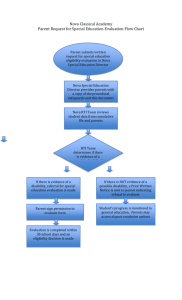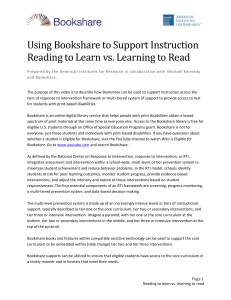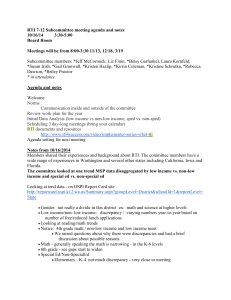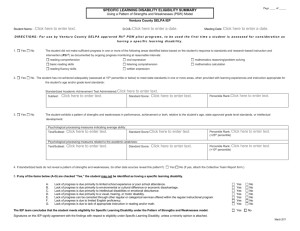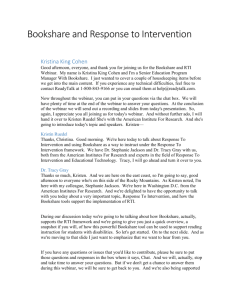Transcript - Bookshare
advertisement
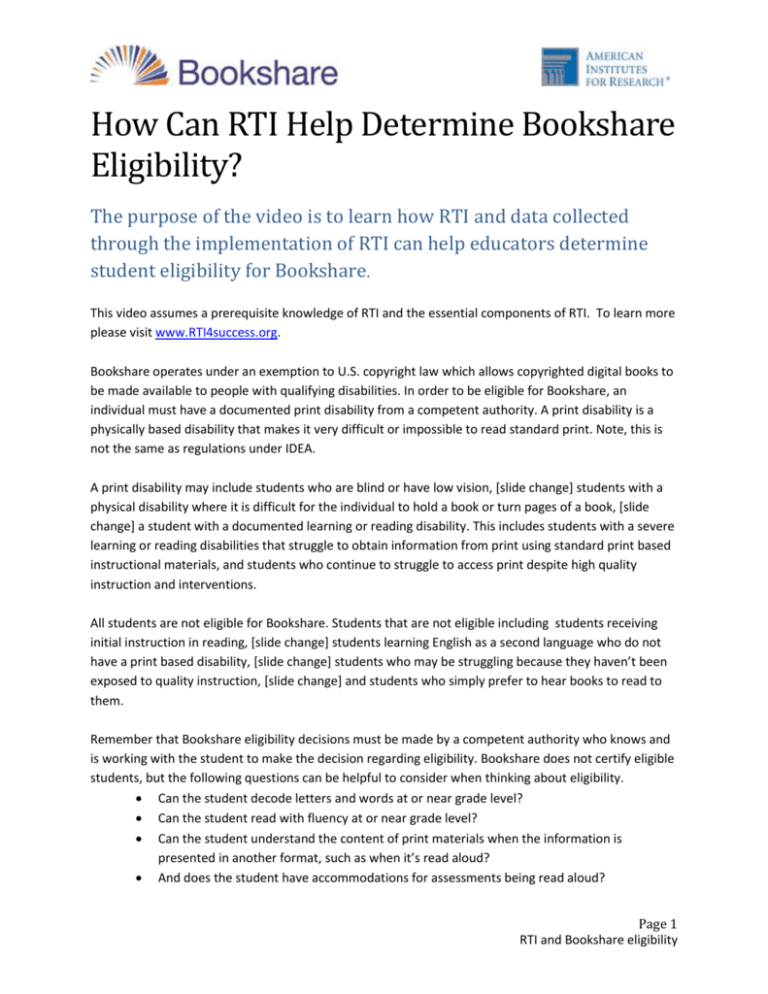
How Can RTI Help Determine Bookshare Eligibility? The purpose of the video is to learn how RTI and data collected through the implementation of RTI can help educators determine student eligibility for Bookshare. This video assumes a prerequisite knowledge of RTI and the essential components of RTI. To learn more please visit www.RTI4success.org. Bookshare operates under an exemption to U.S. copyright law which allows copyrighted digital books to be made available to people with qualifying disabilities. In order to be eligible for Bookshare, an individual must have a documented print disability from a competent authority. A print disability is a physically based disability that makes it very difficult or impossible to read standard print. Note, this is not the same as regulations under IDEA. A print disability may include students who are blind or have low vision, [slide change] students with a physical disability where it is difficult for the individual to hold a book or turn pages of a book, [slide change] a student with a documented learning or reading disability. This includes students with a severe learning or reading disabilities that struggle to obtain information from print using standard print based instructional materials, and students who continue to struggle to access print despite high quality instruction and interventions. All students are not eligible for Bookshare. Students that are not eligible including students receiving initial instruction in reading, [slide change] students learning English as a second language who do not have a print based disability, [slide change] students who may be struggling because they haven’t been exposed to quality instruction, [slide change] and students who simply prefer to hear books to read to them. Remember that Bookshare eligibility decisions must be made by a competent authority who knows and is working with the student to make the decision regarding eligibility. Bookshare does not certify eligible students, but the following questions can be helpful to consider when thinking about eligibility. Can the student decode letters and words at or near grade level? Can the student read with fluency at or near grade level? Can the student understand the content of print materials when the information is presented in another format, such as when it’s read aloud? And does the student have accommodations for assessments being read aloud? Page 1 RTI and Bookshare eligibility You can learn more about Bookshare eligibility at their YouTube channel. Please go to www.youtube.com and search Bookshare. The RTI Framework and its core components, screening, progress monitoring, multi-level prevention system, and data-based decision making, can help educators answer some of these questions and establish whether a student’s academic difficulties are the result of a print-based disability, related to a reading or learning disability or the lack of exposure to quality core instruction and interventions. Screening data collected through RTI implementation allows us to address the questions: How does an individual student compare to his or her peers who have been provided instruction? Does core instruction seem to be working for most students? Is the student performing below the grade level target? Is the student performing below his or her peers? In this example, we see one class’s screening data. The graphic shows students listed on a spreadsheet, based on how they did relative to the target or cut score on the screening assessment. These data show that all the students in the class fall below the target score with some falling well below the target. This suggests the core curriculum is not effective for all students in the class. While this data suggest that students are below the grade level target, data would make it difficult to know whether a student was struggling because they had a print-based disability or if they simply didn’t have access to adequate instruction. District schools and grade level teams can look at district-wide, school-wide, grade-wide, or class-wide performance by grade level over the year based on screening results to understand how students are doing. This chart shows Percent on the y-axis increasing from 10 percent to 100 percent, and Second Grade on the x-axis, with the school year divided into three categories, fall, winter, and spring. By viewing the changes in percentage of students meeting the criteria for each benchmark, we see that only 55 percent of students met the criteria at the beginning of the year, while 80 percent met it at the end of the year. In general, it appears instruction for that year is effective as students as a whole showed improvement across the year. If a student was struggling in a classroom and most of the other students are responding to the core curriculum that would be an indication the student might meet criteria for a print based disability. With screening data, individual student performance can be compared with the norm group showed here in the box plots and the target score which is the black line. This Box and Whisker plot shows Student Percentiles on the y-axis, ranging from 25th percentile to 100th percentile, and Fall, Winter, and Spring on the x-axis, representing a complete school year. The key shows that the target percentile is represented by a bold black line drawn through the center (or 50th percentile) of each box and whisker plot, which ranges from 25th percentile on the lower end to the 75th percentile on the higher end, with Page 2 RTI and Bookshare eligibility the whiskers extending down to the 10th percentile and the up to the 90th percentile. The boxes are colored green, and the individual student’s data are identified by a blue dot. If you look at the green boxes, you can see that the group appears to be making progress over time while the student shown in blue is making some progress across the year but his progress appears to be insufficient to close the gap with his peers. In fact, look closely, it appears the gap may actually be increasing as the school year progresses from fall to spring, as shown by the increasing difference between the 50th percentile of the peer group and the student’s benchmark score. The student is also far below the grade level target. Thus, this is a student who may be eligible for additional support and Bookshare. Together, if screening data indicates that all students receiving the core instruction are struggling, it may be difficult or impossible to know whether the student is struggling as a result of a print based disability or the simple lack of exposure to quality instruction. But if peers are performing well, and the student is far below grade level, it may be an indication that additional assessment is necessary to identify whether they would qualify as a student with a print based disability and be able to benefit from Bookshare. Progress monitoring data allows us to understand: Is the student making progress over time? Is the student responding to evidence-based interventions? And is the student making progress towards his or her goals at grade level targets? In this example we can see that a student has not been responsive to instruction and continues to struggle to read with fluency. The scatterplot graph has Words Read Correctly on the y-axis, increasing from zero to 30, and Weeks of Instruction on the x-axis, increasing from one to fourteen. After eight weeks of instruction the student’s number of words read correctly is between 10 and 15, the same range from where the student started at week one. The goal line is represented with a dashed line moving in a positive, upward slope, extending to 20 words read correctly by week thirteen. As it stands, the student trend line is below the student projected goal line. This indicates the student is not on target to meet grade level bench marks for oral reading fluency and may provide some data that can support a competent authority in determining if the student is eligible for Bookshare. In contrast, in this graph we see the student was not originally making progress, but after an intervention change indicated by the dashed line between weeks eight and nine the student is making progress. This scatterplot graph also has Words Read Correctly on the y-axis increasing from zero to 30, and Weeks of Instruction on the x-axis, ranging from one to twenty. However in this graph, once the intervention change began between weeks eight and nine, the student’s progress is evident by their increase in words read correctly each week. This suggests that with the support of an evidence based intervention, the student is able to make progress toward their goal of reading fluently and would likely not be eligible for Bookshare as they were able to make substantial progress when provided with additional support. Page 3 RTI and Bookshare eligibility As we just saw from progress monitoring data understanding student response to more intensive interventions helps us know whether students are able to make progress when provided with instruction that matches their needs. Multilevel prevention systems provide a systematic way to ensure that students are provided with intensive interventions based on need. Secondary or tier 2 interventions utilize evidence based intervention programs, and tier 3 interventions provide intensive intervention tailored to individual student needs. When a student’s data suggest that they are unresponsive to a continuum of supports, ranging from high quality core instruction to intensive individualized intervention, it may suggest that they have a severe learning or reading disability leading them to the struggles to obtain information from print using standard print-based instructional approaches, and as a result, may benefit from Bookshare. Data from RTI implementation including screening, progress monitoring, and diagnostic data can help identify student specific areas of and may provide helpful information as a competent authorities identify whether a student has a print-based disability that would make them eligible to benefit from Bookshare. In summary, the RTI framework and the essential components can help a competent authority determine if a student’s academic difficulties are the result of a print based disability or a lack of exposure to quality instruction by reviewing how students perform in comparison to their peers and how they respond to a continuum of more intensive interventions. In addition, screening and progress monitoring data can provide documentation to support decisions. While documented data from an RTI framework may be helpful for determining Bookshare eligibility, Bookshare eligibility is ultimately determined by certifying professionals and additional data may be necessary to make decisions. Additional resources on RTI, intensive intervention, and Bookshare are available at the following links: The Center on Response to Intervention www.rti4success.org, the National Center on Intensive Interventionwww.intensiveintervention.org, Bookshare www.bookshare.org. This project is supported by the U.S. Department of Education, Office of Special Education Programs (Cooperative Agreement #H327D120002). Opinions expressed herein are those of the authors and do not necessarily represent the position of the U.S. Department of Education. Page 4 RTI and Bookshare eligibility
